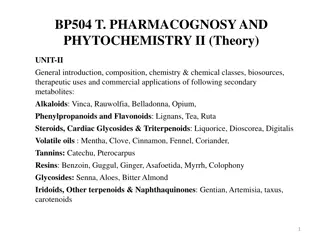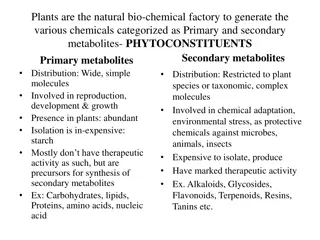Exploring Secondary Metabolites in Ruta Graveolens for Therapeutic Applications
Delve into the world of secondary metabolites found in Ruta graveolens, commonly known as Rue or Garden Rue. Discover its rich composition of alkaloids, phenylpropanoids, flavonoids, steroids, cardiac glycosides, triterpenoids, volatile oils, tannins, resins, glycosides, iridoids, and other terpenoids. Uncover its biological sources, including the entire plant, and learn about its historical uses as a medicinal herb, condiment, and insect repellent. Explore the descriptive characteristics of this herbaceous perennial evergreen shrub and its potential therapeutic benefits.
Uploaded on Sep 13, 2024 | 0 Views
Download Presentation

Please find below an Image/Link to download the presentation.
The content on the website is provided AS IS for your information and personal use only. It may not be sold, licensed, or shared on other websites without obtaining consent from the author. Download presentation by click this link. If you encounter any issues during the download, it is possible that the publisher has removed the file from their server.
E N D
Presentation Transcript
Anju Singh School of Pharmaceutical Sciences, CSJM University, Kanpur 1
UNIT-II General introduction, composition, chemistry & chemical classes, biosources, therapeutic uses and commercial applications of following secondary metabolites: Alkaloids: Vinca, Rauwolfia, Belladonna, Opium, Phenylpropanoids and Flavonoids: Lignans, Tea, Ruta Steroids, Cardiac Glycosides & Triterpenoids: Liquorice, Dioscorea, Digitalis Volatile oils : Mentha, Clove, Cinnamon, Fennel, Coriander, Tannins: Catechu, Pterocarpus Resins: Benzoin, Guggul, Ginger, Asafoetida, Myrrh, Colophony Glycosides: Senna, Aloes, Bitter Almond Iridoids, Other terpenoids & Naphthaquinones: Gentian, Artemisia, taxus, carotenoids 2
Ruta is known by the name Rue herb of grace or common rue is grown as an ornamental plant Herb is used for Medicinal prop. used as condiment & as a insect repellent also It has strong smelling leaves It was known to ancient Romans, natural pedanius dioscorides & pliny the elder. They recommended that the rue in combination with poisonous shrub oleander can be taken as an antidote to poisonous snake bites In Southern India, Rue is grown in home gardens to repel snakes 3
Biological source: consist of entire plant, Ruta graveolens Family: Rutaceae Garden Rue (Ruta graveolens L.) It is commonly known as Rue/Common Rue/Garden Rue/ Herb of Grace Rutaceae , genus Ruta in Latin, means Bitter and species graveolens means strong smelling Indigenous to Mediterranean region and distributed in South America, China, India, Middle East and South Africa 4
Description Herbaceous perennial evergreen medicinal shrub with blue-green foliage and grows up to 75 cm heigh Leaves are compound, shortly petiolate with ultimate segments obovate-oblong Flowers are yellow in colour with 4-5 petals Fruits are capsules and shortly pedicelled contains numerous seeds Organoleptic characters color: bluish green leaves, odour: strongly aromatic & characteristic , Taste: pungent , Flower: greenish yellow 5
Rue contains about 0.5% of volatile oil, flavonoids, coumarins, and furoquinoline alkaloids which are valued in pharmaceutical industry Responsible for the bitter taste is Rutin (7 to 8% in the dried leaves) Chemical constituent: Flavanoid glycoside: Rutin pale yellow color cyrstalline compound Alkaloids: Rutalinium, dictamine, rutamin etc. Fixed oil: linoleic acid, stearic, palimitic, acid Volatile oil: limonene, cineole, ethyl valerate, methyl salicylate, caryophylline, myrecine Others: Psoralin, bergaptin, graveoline, rutarin 6
also called rutoside, quercetin-3-O-rutinoside and sophorin, is the glycoside combining the flavonol quercetin and the disaccharide rutinose ( -L-rhamnopyranosyl-(1 6)- -D-glucopyranose). It is a citrus flavonoid found in a wide variety of plants including citrus. Rutin on hydrolysis give quercetin and Rhamnose plus glucose 2-(3,4-dihydroxyphenyl)-5,7-dihydroxy-3-[ -L-rhamnopyranosyl-(1 6)- -D- glucopyranosyloxy]-4H-chromen-4-one 7
Uses Capillary protectant , antitussive, Spasmolytic, Emmenagoggue (to stimulate menstrual flow) (infusion or liq. extract), Rutin used in combination with ascorbic acid to treat capillary bleeding, blood vessel protectant pharmacological activities including contraceptive, anti-inflammatory, antimicrobial, antipyretic, antioxidant, analgesic, antihyperglycemic, free radical scavenging, hypotensive, antiviral, and antiplasmodial effects. 8
Biological It contains the prepared leaves and leaf buds of Thea sinensis (Linne) kuntz., belonging to family Theaceae. Geographical It is mainly cultivated in India (Assam), Ceylon, Japan and Java. Organoleptic characters: Taste: Bitter, astringent Color: Dark green, Odour agreeable CC.: Condensed tannins, derivatives of Biological Source Source Geographical Source Source 9
Leaves are dark green in colour, lanceolate or elliptical, on short stalks, blunt at apex, base tapering, margins shortly serrate, young leaves hairy, older leaves glabrous. 10
Trace compounds: Amino acids, proteins, yellow volatile oil (responsible for odor) Purine Alkaloids: Xanthine bases- caffeine 1-3 %, Theobromine, Theophylline in mior amts., enzymatic mixture called thease Color of leaves : because of gallotannic acid Caffeine: 1,3,7, tri methyl xanthine Chemical Test: For caffeine, purine alkaloids 11
Flavanol: Catechin, epicatechin, epigallocatechin, Gallotannic acid (15-20%), epicatechin gallate Potentiates the action of ergotamine tartarate & enhances the analgesic activity in migraine OH HO O OH OH Natural phenol & antioxidant 2 benzene rings, dihydropyran heterocycle with hydroxyl group on C 3, A ring similar to resorcinol, B is similar to catechol moiety 4 diastereoisomers, 2 are catechin, 2 are epicatechin OH 12
Chemical Tests 1. Caffeine and other purine alkaloids, gives murexide colour reaction. Caffeine is taken in a petridish to which hydrochloric acid and potassium chlorate are added and heated to dryness. A purple colour is obtained by exposing the residue to vapours of dilute ammonia. In addition of fixed alkali the purple colour disappears. 2. Caffeine also produces white precipitate with tannic acid solution. Uses CNS stimulantdue to cerebral vasoconstrictor, In diabetes as diuretic, astringent, antioxidant, beverages, green tea- obesity, weight loss, 13























